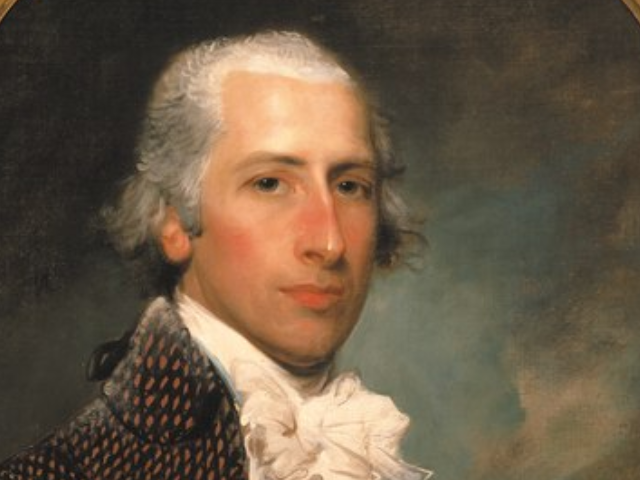
Portrait of Gabriel Manigault. 1794. Painted by Gilbert Stuart. Wikimedia Commons.
(1758-1809) Manigault was the son of Peter Manigault and Elizabeth Wragg. While studying law in London in the 1770s, Manigault became familiar with the work of the Scottish architect Robert Adam, the dominant figure in English architecture during the late eighteenth century. He returned to Charleston in 1780 familiar with Adam’s brand of neoclassicism, which drew on sources from ancient Rome to the cinquecento.
Manigault returned to Charleston in order to protect his family’s property. Although he participated in the defense of Charleston, he took the oath of allegiance to the king several months after the city fell. After the war he turned his attention to rice planting on the nearly 25,000 acres he had inherited. The wealth afforded him the opportunity to pursue architecture.
Manigault brought to Charleston an architectural conception that bridged the Anglo-Palladianism of the mid–eighteenth century and the emergence of the Greek revival in the 1820s. He is generally credited with designing the Branch Bank of the United States (1800–1804), an elegant building dominated by a two-story hall across the facade. As a gentleman architect, Manigault provided the plans but left carpenters Edward Magrath and Joseph Nicholson and mason Andrew Gordon to supervise construction. Manigault produced a more fully realized example of Adamesque classicism in his design for the South Carolina Society Hall (1803–1804), which juxtaposes a subdued exterior with a more elaborate interior. Built on a T-plan with two stories over a service basement, the building features a second-story ballroom with a colonnaded neoclassical canopy. Another important example of Manigault’s work was the Orphan House Chapel (1807), a two-story roughcast brick structure with a pediment supported by four engaged columns on the facade.
Manigault excelled as an architect of domestic buildings. About 1803 he designed a house for his brother that stood three stories tall over a high basement. The house was built of brick and has the character of an urban villa. The exterior is distinguished not by ornament but by full-height curvilinear bays on the north and east elevations and a semicircular double-tiered piazza on the west. The interior plan incorporates a graceful sequence of interconnected entertaining rooms embellished with Adamesque detailing. The formal entrance hall, dining room, and drawing room feature elaborately carved mantles and moldings, and a large plaster medallion ornaments the ceiling of the stairway.
Manigault represented St. James Goose Creek Parish in the South Carolina House of Representatives from 1785 to 1793. Manigault was also a trustee for the College of Charleston and a charter member of the South Carolina Jockey Club. Manigault married Margaret Izard on May 1, 1785. They had ten children, three of whom died in infancy. In 1805 Manigault moved to Philadelphia, and he died there in1809.


